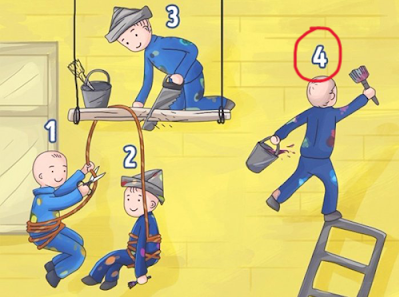Life is full of little puzzles that challenge our logic and observational skills. The picture above is one such mind-boggling riddle. At first glance, it looks like a simple situation involving a group of painters working on a yellow wall, but the challenge lies in answering this seemingly straightforward question: Who will fall first?
Before diving into the solution, let’s analyze the scenario carefully and unravel the mystery step by step. This blog post will guide you through the common pitfalls when solving puzzles like this, provide step-by-step reasoning to reach the answer, and encourage you to develop your logical thinking. Ready to test your observational skills? Let’s dive in!
1. The Puzzle at Hand: Can You Solve It?

Take a moment to look at the image. We see four painters:
- Painter #1 is holding a rope that seems to be connected to Painter #2.
- Painter #2 sits comfortably on a wooden plank suspended by the rope Painter #1 is holding.
- Painter #3 is working on top of the same wooden plank but is using a saw to cut it in half.
- Painter #4 is standing on a ladder with a paint bucket and brush.
Your task? To determine who will fall first.
This puzzle invites us to scrutinize the details, challenge assumptions, and question what might happen next. It’s not as simple as it seems! Many people jump to conclusions, and that’s exactly where the fun begins.
2. Common Mistakes When Solving the Puzzle
It’s easy to misinterpret puzzles like these because our brain loves to make quick assumptions. Here are some typical errors people make when attempting to answer this riddle:
- Ignoring the Dynamics of Movement: Many assume that all painters are stationary, but movement (such as cutting, climbing, or balancing) plays a critical role.
- Overlooking Small Details: The rope, the plank, the ladder’s stability—every element matters. Missing one key detail can lead to the wrong conclusion.
- Focusing on the Obvious: Painter #3 cutting the plank might seem like the biggest threat at first glance, but there are other factors at play.
- Neglecting Physics: Weight distribution, gravity, and cause-effect relationships are critical here. Overlooking these principles can lead to inaccurate answers.
3. Step-by-Step Guide to Solving the Puzzle
Now, let’s break down the image and analyze each painter’s situation systematically:
Painter #4: The Ladder Dilemma
Painter #4 is standing on a ladder while holding a bucket of paint. Here’s why they are a prime candidate for falling first:
- The ladder looks precarious. If it isn’t stable or if Painter #4 makes a sudden move, they might lose balance.
- If the ladder slips, Painter #4 will undoubtedly be the first to fall.
- The bucket adds extra weight, increasing the chance of instability.
Thus, Painter #4 is the most likely to fall if the ladder moves. However, if the ladder remains stable, they might remain safe.
Painter #3: Cutting the Plank
Painter #3 is actively sawing through the wooden plank. Logically:
- If Painter #3 finishes cutting the plank, they will fall, along with Painter #2, who is sitting on it.
- However, cutting through a plank takes time. Painter #3 might not complete the action before something else happens.
Therefore, while Painter #3’s actions are risky, their fall is dependent on how quickly the plank is cut.
Painter #2: Sitting on the Plank
Painter #2’s fate is tied to the stability of the plank. If:
- Painter #3 succeeds in cutting the plank, Painter #2 will fall.
- Painter #1 loses grip on the rope, Painter #2 will fall as well.
- Painter #2 is relatively passive, relying entirely on the actions of others.
Painter #2 is vulnerable but unlikely to fall first unless someone else causes it.
Painter #1: Holding the Rope
Painter #1 is holding a rope that supports both the plank and Painter #2. Key observations:
- If Painter #1 lets go of the rope, Painter #2 will fall immediately.
- Painter #1 is stable on the ground, making them the least likely to fall unless they intentionally release the rope or are impacted by something external.
Painter #1’s position is safe, as long as they maintain their grip.
4. The Likely Outcome: Who Will Fall First?
After analyzing each painter’s position, it’s clear that Painter #4 is the most likely to fall first—but only if the ladder moves or loses balance. If the ladder remains stable, the situation shifts to Painter #3, who is actively cutting the plank. Their actions could lead to both their own fall and Painter #2’s, making them a close second in terms of likelihood.

However, this puzzle also leaves room for interpretation. Painter #1 could lose grip, or Painter #3 might take longer to cut the plank than expected, altering the sequence of events. The key takeaway? Small details, like the movement of the ladder or the tension in the rope, hold the answers.
5. Why This Puzzle Challenges Our Logic
This puzzle is a fantastic example of how we often overlook small but significant details. It requires us to:
- Evaluate multiple perspectives.
- Understand cause-and-effect relationships.
- Think critically about the dynamics of movement and stability.
By breaking the problem into smaller components, we can approach it more systematically and arrive at a logical conclusion.
6. Your Turn: What’s Your Answer?
Now that we’ve walked through the analysis, it’s time for you to weigh in! Do you agree that Painter #4 is the most likely to fall first? Or do you think another painter is at greater risk? Share your thoughts in the comments below.
And if you enjoyed this puzzle, why not challenge your friends and family? It’s a fun way to test their logical reasoning and observational skills.
7. Final Thoughts: The Joy of Solving Puzzles
Riddles like this one not only entertain us but also sharpen our minds. They teach us to pay attention to details, think critically, and challenge assumptions. If you found this puzzle intriguing, consider exploring more brain teasers and logical challenges. The more you practice, the sharper your reasoning becomes.
So, who do you think will fall first? Comment below, share your analysis, and let’s keep the discussion going! Remember, there’s no single way to interpret this puzzle—every perspective adds value. Happy puzzling!


